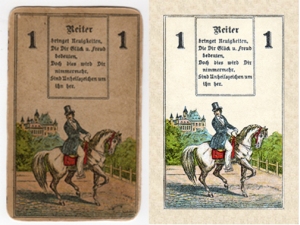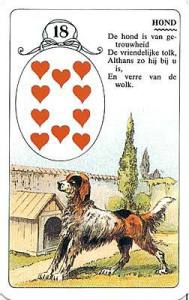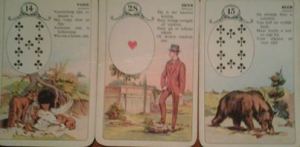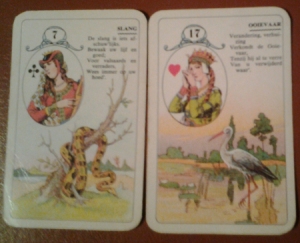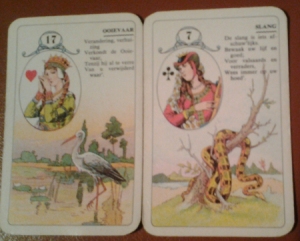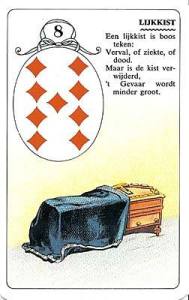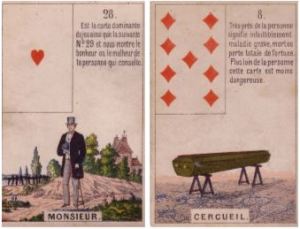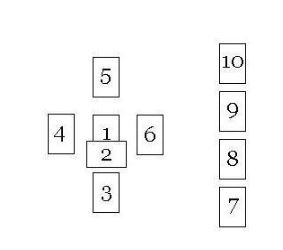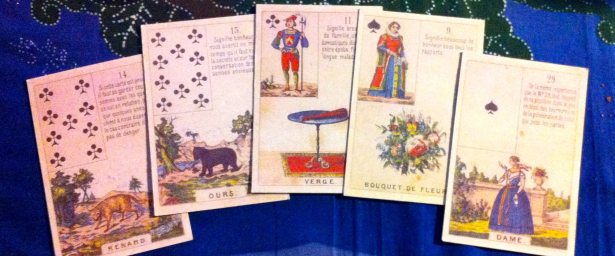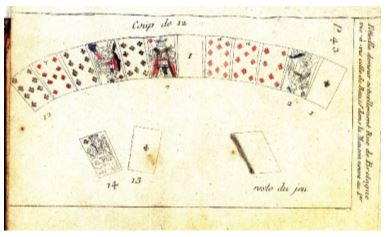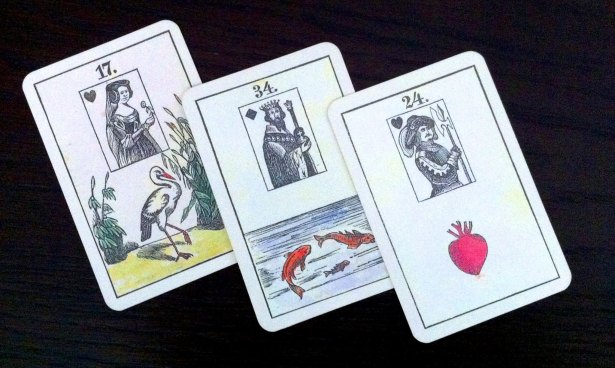(Interviewed by Caitlín Matthews)
What drew you to reproduce antique Lenormand decks?
This is a long story. Are you sure you want it?
When I first became enamored with the Lenormand it didn’t take long to be drawn to the antique decks because of the simplicity and clarity of the symbols.
I remember vividly when it began. I read Le Fanu’s blog in September of 2012 and saw his new find: Dondorf’s first Lenormand deck. Loved the lilac circles containing the card numbers and, opposite at the top, the publisher’s name visually balancing the card. Many of the colors differed from the Dondorf decks that I already had. And I was smitten with the colors that of the signature Dondorf back design.
I already had the large and small versions of the Carreras tobacco cards and the French Cartomancy version that use the Dondorf art. While I admire the art of the Dondorf decks, they all share flaws that I wanted to correct.
So I set about making up a mini version of the Dondorf design. Online I found another version of the Dondorf that contained a dragon in the circle opposite the card’s number. I decided to use the dragon and make it purple to match the number’s background.
Another change I made was that, since I like black horses, the Rider’s horse became a black horse. The other changes that I felt necessary were to make the clouds lighter on one side, and to enable the Lord and Lady to face each other.
Something that the modern French Cartomancy deck lacked was a suitable back to complement the Dondorf faces. I decided to use the back from one of the Carreras decks that I had, with some minor changes, because the backs were so lovely. After all, one does spend a lot of time looking at the backs of the cards, and so I thought that the backs must be beautiful, too.
I thought that since I was going to create a mini and I didn’t know whether anyone was making minis, I decided make a few and sell them on eBay. The rationale was that if I liked minis someone else probably would, too.
One evening I saw a reference on one of the forums to the “Original Lenormand” deck that someone had produced from cards found at the British Museum. The post contained a link to the British Museum. There I found a picture of all the cards, the title of which translated as the “Game of Hope,” laid out together. I found the images so charming that I embarked on a search to find a copy for myself when I discovered that they had been produced as a limited edition. I was severely disappointed when I found they were, alas, sold out. I searched the ‘net and none was to be found anywhere, including ebay.
I went directly to the British Museum. I was staggered to find what it would cost to buy a license to make one deck for myself, and shelved the idea but continued my search.
Eventually my friend suggested that since neither of us could find a copy of the limited edition deck and we both really wanted one, maybe some other people who’d missed the limited edition would want one, too.
I took the plunge, contacted the British Museum and bought a license to produce it. I launched a website in the hope of selling sell enough decks to recover the expense of securing the rights to make them. That’s all I really wanted: a copy of the deck for myself.
Since I made my first 2, what I called my “Purple Dragon” Dordorf deck and the “Game of Hope,” I am afraid that finding and restoring the antique cards has become almost an obsession.
What processes do you use to clean up old original decks and restore them to their beauty? What is your artistic background?
I was employed many years as a graphic artist and video producer/editor until my retirement, and subsequently continued to do random freelance advertising using Photoshop. I first began using Photoshop at the time of its introduction in 1990 as Photoshop 1.0. Since I work with digital images, not the fragile original cards, my tool is the computer using Photoshop.
When restoring them to a usable condition in the form of playing cards, I must work within the constraints of the templates provided by a printer. Specifying a non-standard size to accommodate the unique size of each deck would be very expensive because of the large quantities that must be ordered. Since I like the image larger and the border smaller, I need to choose a size that will best fit the originals and then adjust the aspect ratio to fill the space to allow for the largest possible image.
Then, since I have been working with Photoshop for many years, auto pilot takes over and I can selectively adjust the colors and contrast and otherwise manipulate the image in order to restore it to its former glory. The old, bent and abused cards are not always ‘square’ so they must be digitally straightened. Then the blemishes need to be corrected and, in some instances, parts of the picture must be reconstructed.
Some of the decks are easy to work on because they were probably relatively unused. But for the decks that were used and abused, each and every card needed individual attention, and the methods I used for each would take a lengthy lecture on the intricacies of Photoshop. Suffice it to say that many of the cards required on-screen high magnification to receive the detailed attention needed to restore their original beauty.
What makes these traditional decks so special?
I think the primary reason these antique decks are so special is because of the clean, uncluttered, and especially the original art. When I lay a line or a full board spread of these cards, I don’t have to look hard to see the symbols. The symbol jumps out and makes it easy to read the cards and see the relationships between the cards without having to visually wade through a lot of scenery or extraneous clutter that would divert my attention.
I also am drawn to the old decks because the art. I appreciate the elegant execution and straightforward and unpretentious pictures on the cards. The talented artists of all the decks, through their work, impart the flavor of the era in which they were created. Somehow they speak to me with a clarity that I haven’t experienced with any of the new crop of decks that appear almost daily.
What is your vision for the future of the Lenormand oracle?
The Lenormand grew from a few fortune tellers who discovered that the Divine was content to communicate with them through these cards. Through these conversations those fortune tellers developed a language that became a common language that could be passed on to and understood by others; a folk tradition named for Mlle Lenormand but brought to its maturity in the years following her departure from the Earth.
This is a clear, concise oracle that in my view needs little improvement. As times change, the concerns of people who want to consult it do not change; nor do the basic meanings of the symbols that are easily applied to the techno society that has since evolved. It is my hope that there are enough people who appreciate its history, who want to preserve the integrity of the Lenormand “language,” so that in another hundred years it will still be read in the same ways that it has been for the past 200 years.
Do you have a favourite among the decks you reproduce?
If I had to choose only one as a favorite deck that I have worked on, it would be one of the Dondorfs. However, whenever I pick up a different deck every so often, that one will become my new love — for awhile. My latest ‘love’ is one I have been working on lately, the Schmid, from the 1950s. It is definitely a period piece because the Gentleman is standing casually smoking a cigarette, which is totally apropos of its time.
What special difficulties do you encounter in this work?
Restoring these old cards began when I discovered my new passion for the Lenormand. I admired some of the beautiful antique decks that I saw online that were totally unavailable, or at the very least out of reach because of their rarity or their price.
After I bought one of the lovely old Carreras Dondorf decks, I was disappointed that, while they were gorgeous, they were fragile and therefore unusable if I wanted to preserve them. And they smelled awful and left my hands smelling just as bad. Handle them with gloves?? I think not. Then a light bulb went on: I have the skills to resurrect them and share the bounty with other people who also love the cards! I am so familiar with Photoshop that it was not difficult to find solutions to each problem that faces me with almost every card. I found each challenge fun to surmount. Clover + Mountain + Star.
What have you learned from such close attention to each card?
Spending time with each card was an intimate experience that gave me time to ponder its potential with regard to other cards. While I make no claim to be a fluent reader, I continue to muddle through and am enjoying every step of the way.
Lauren Forestell is the only producer of Lenormand decks fully endorsed by the Traditional Lenormand Fortunetellers Guild. You can purchase her works at http://gameofhopelenormand.bigcartel.com/
